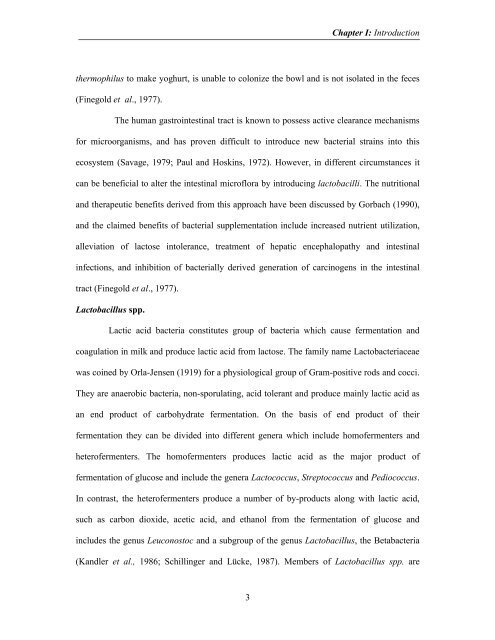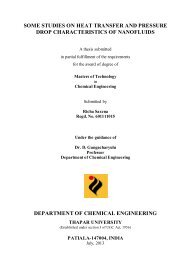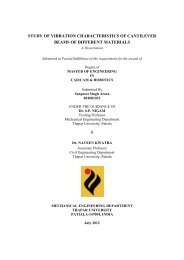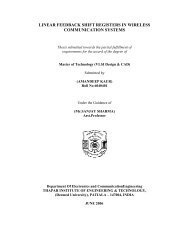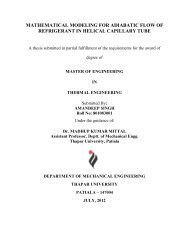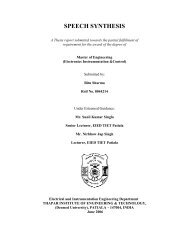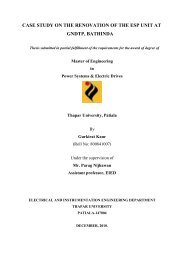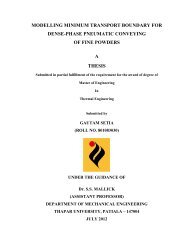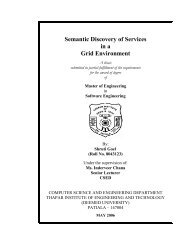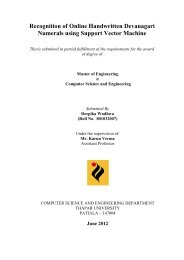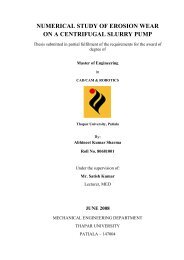from indigenous fermented foods and human gut ... - Thapar University
from indigenous fermented foods and human gut ... - Thapar University
from indigenous fermented foods and human gut ... - Thapar University
Create successful ePaper yourself
Turn your PDF publications into a flip-book with our unique Google optimized e-Paper software.
3<br />
Chapter I: Introduction<br />
thermophilus to make yoghurt, is unable to colonize the bowl <strong>and</strong> is not isolated in the feces<br />
(Finegold et al., 1977).<br />
The <strong>human</strong> gastrointestinal tract is known to possess active clearance mechanisms<br />
for microorganisms, <strong>and</strong> has proven difficult to introduce new bacterial strains into this<br />
ecosystem (Savage, 1979; Paul <strong>and</strong> Hoskins, 1972). However, in different circumstances it<br />
can be beneficial to alter the intestinal microflora by introducing lactobacilli. The nutritional<br />
<strong>and</strong> therapeutic benefits derived <strong>from</strong> this approach have been discussed by Gorbach (1990),<br />
<strong>and</strong> the claimed benefits of bacterial supplementation include increased nutrient utilization,<br />
alleviation of lactose intolerance, treatment of hepatic encephalopathy <strong>and</strong> intestinal<br />
infections, <strong>and</strong> inhibition of bacterially derived generation of carcinogens in the intestinal<br />
tract (Finegold et al., 1977).<br />
Lactobacillus spp.<br />
Lactic acid bacteria constitutes group of bacteria which cause fermentation <strong>and</strong><br />
coagulation in milk <strong>and</strong> produce lactic acid <strong>from</strong> lactose. The family name Lactobacteriaceae<br />
was coined by Orla-Jensen (1919) for a physiological group of Gram-positive rods <strong>and</strong> cocci.<br />
They are anaerobic bacteria, non-sporulating, acid tolerant <strong>and</strong> produce mainly lactic acid as<br />
an end product of carbohydrate fermentation. On the basis of end product of their<br />
fermentation they can be divided into different genera which include homofermenters <strong>and</strong><br />
heterofermenters. The homofermenters produces lactic acid as the major product of<br />
fermentation of glucose <strong>and</strong> include the genera Lactococcus, Streptococcus <strong>and</strong> Pediococcus.<br />
In contrast, the heterofermenters produce a number of by-products along with lactic acid,<br />
such as carbon dioxide, acetic acid, <strong>and</strong> ethanol <strong>from</strong> the fermentation of glucose <strong>and</strong><br />
includes the genus Leuconostoc <strong>and</strong> a subgroup of the genus Lactobacillus, the Betabacteria<br />
(K<strong>and</strong>ler et al., 1986; Schillinger <strong>and</strong> Lücke, 1987). Members of Lactobacillus spp. are


